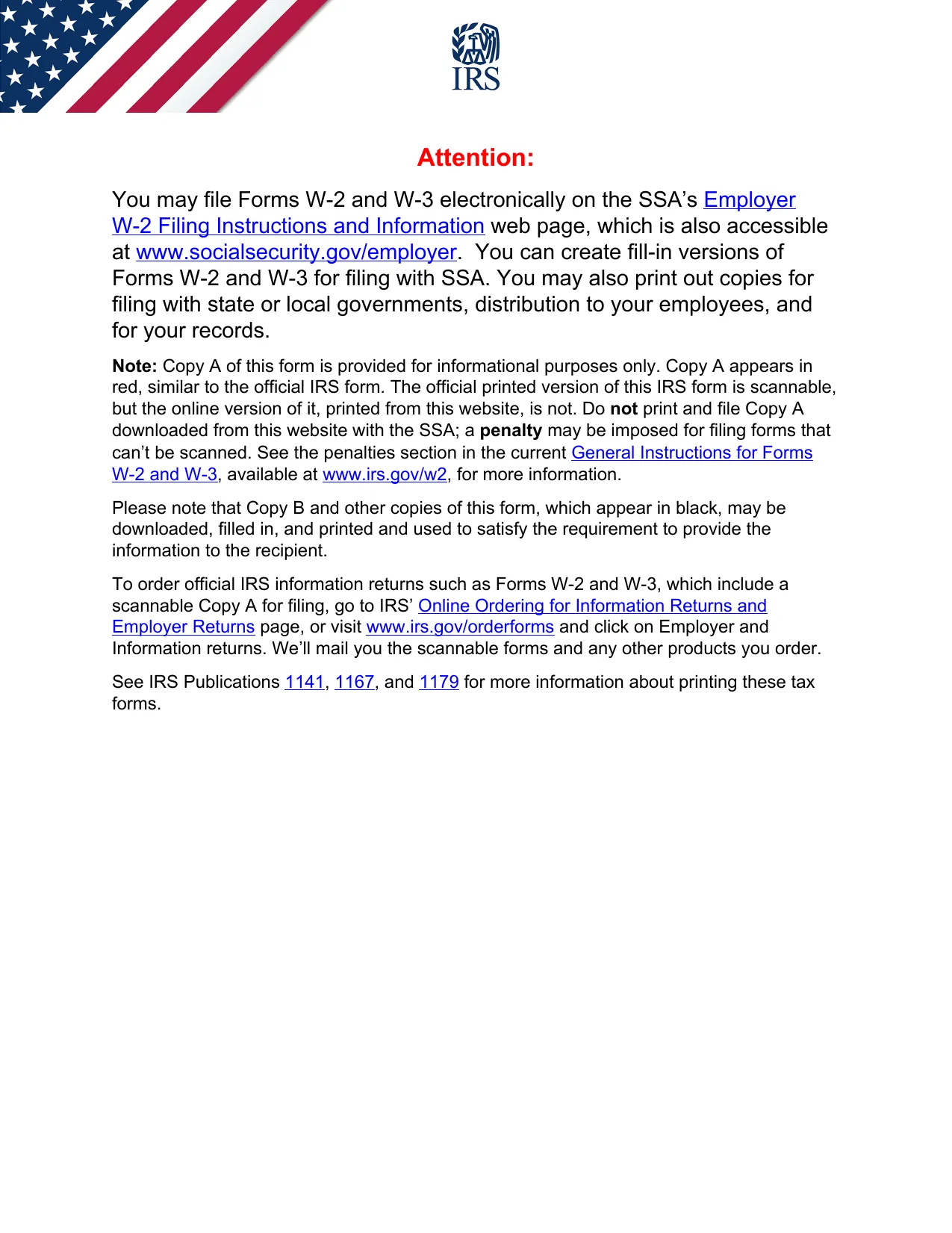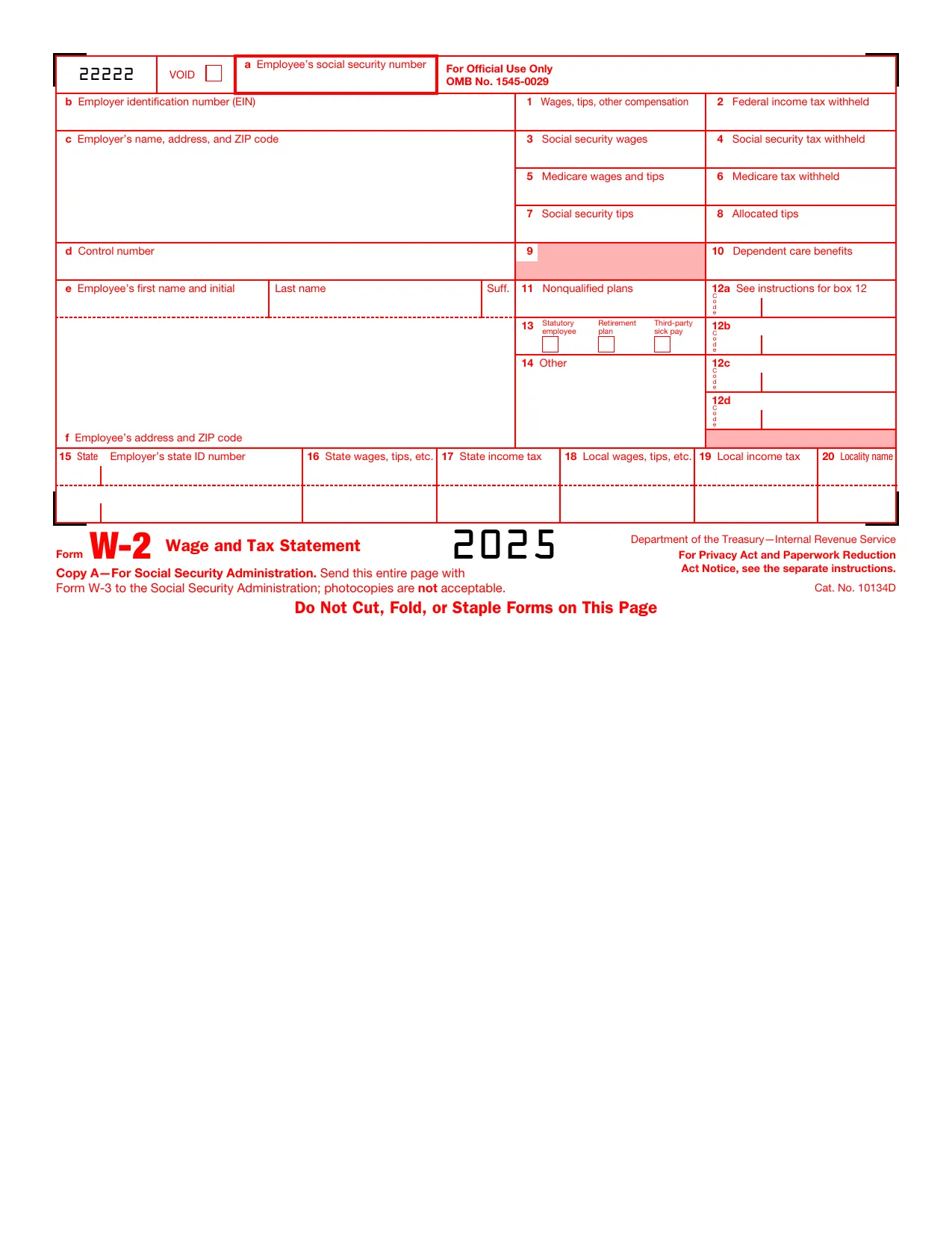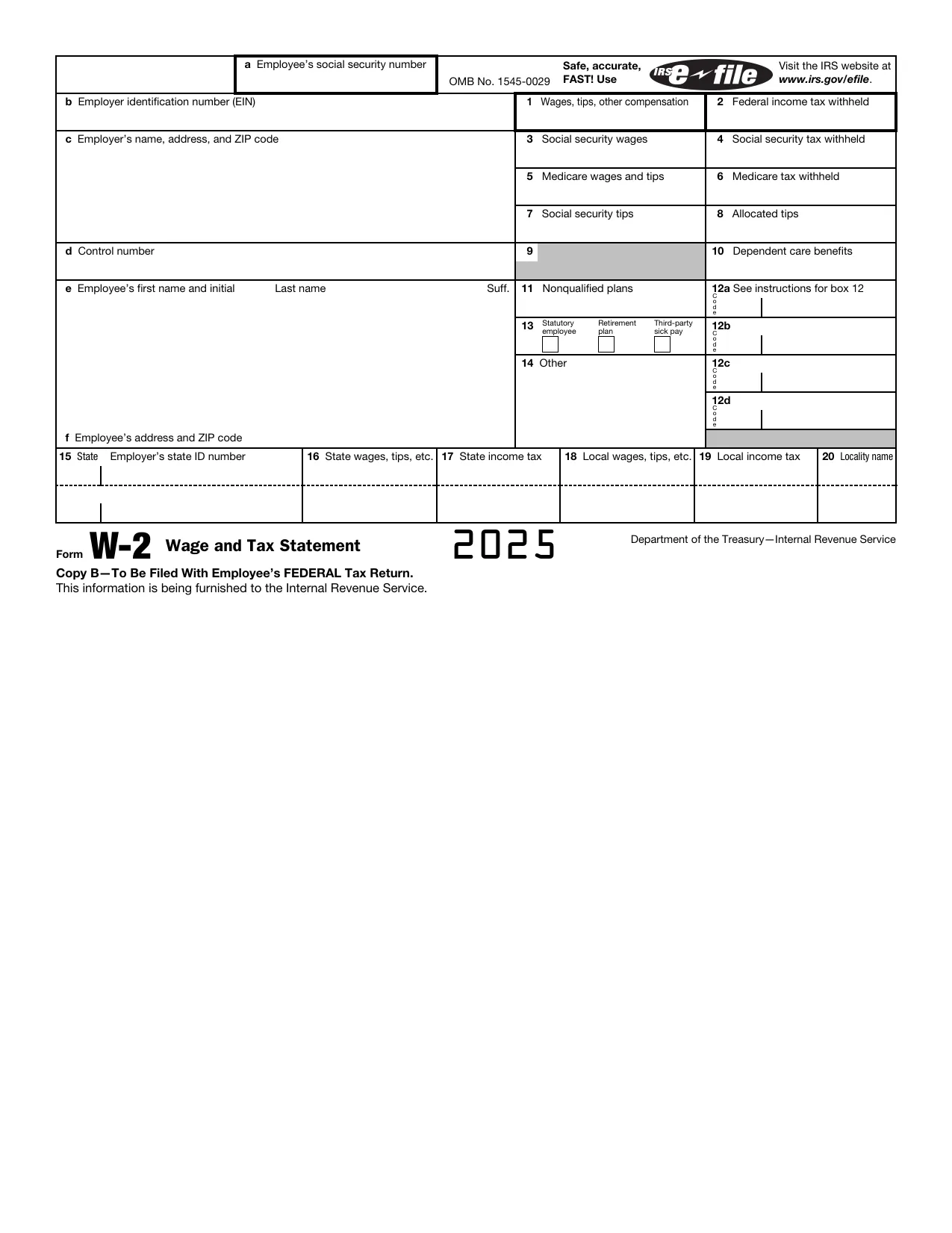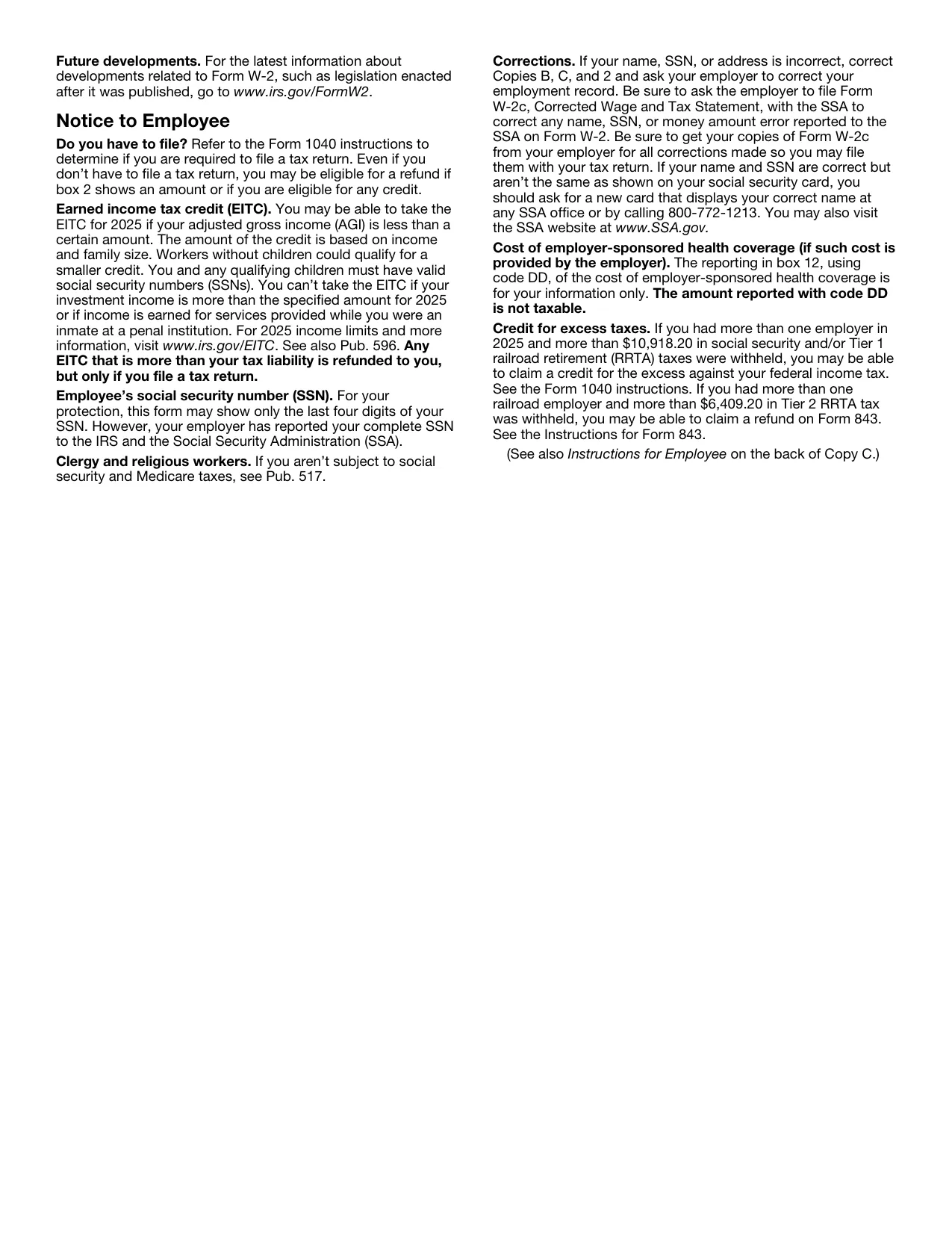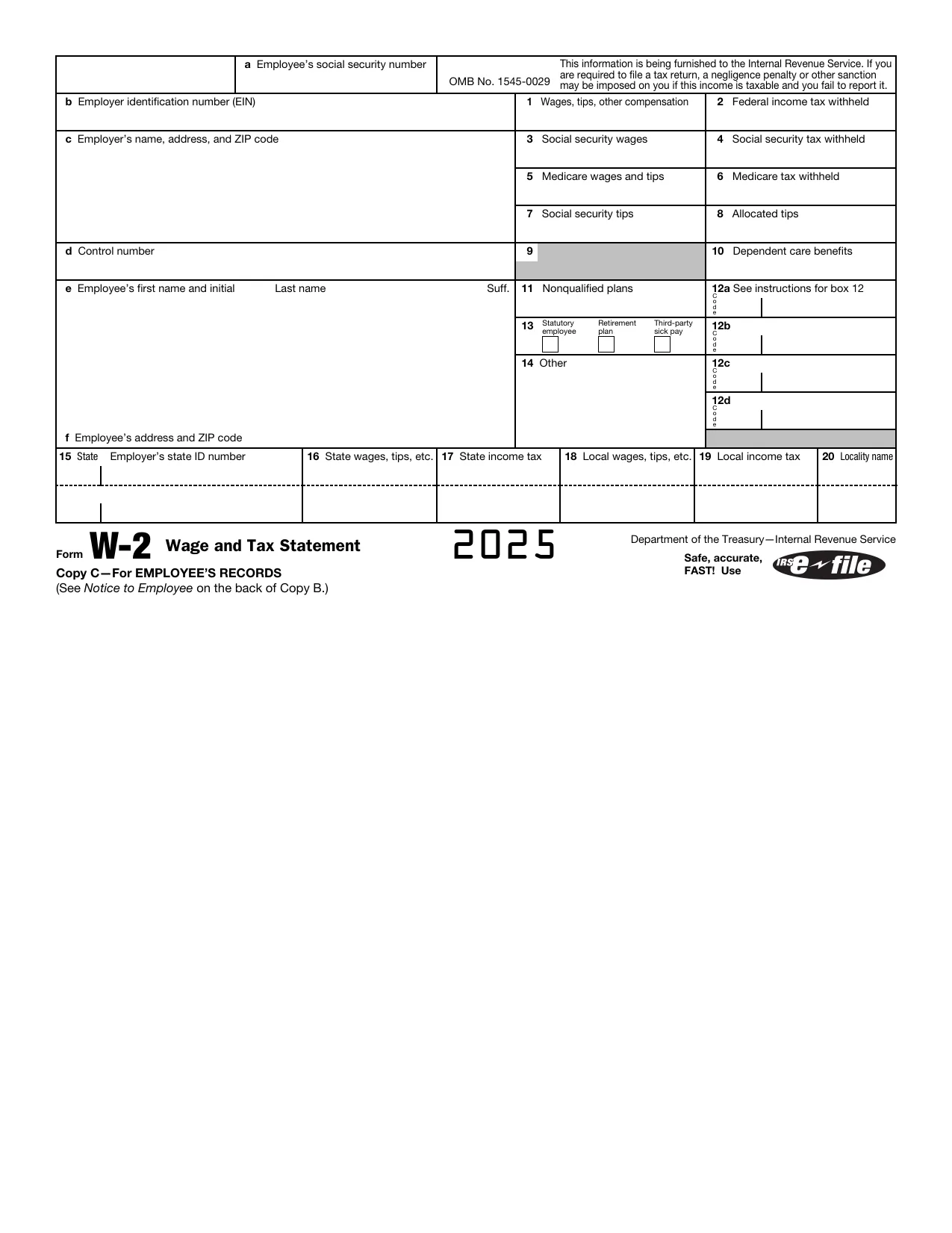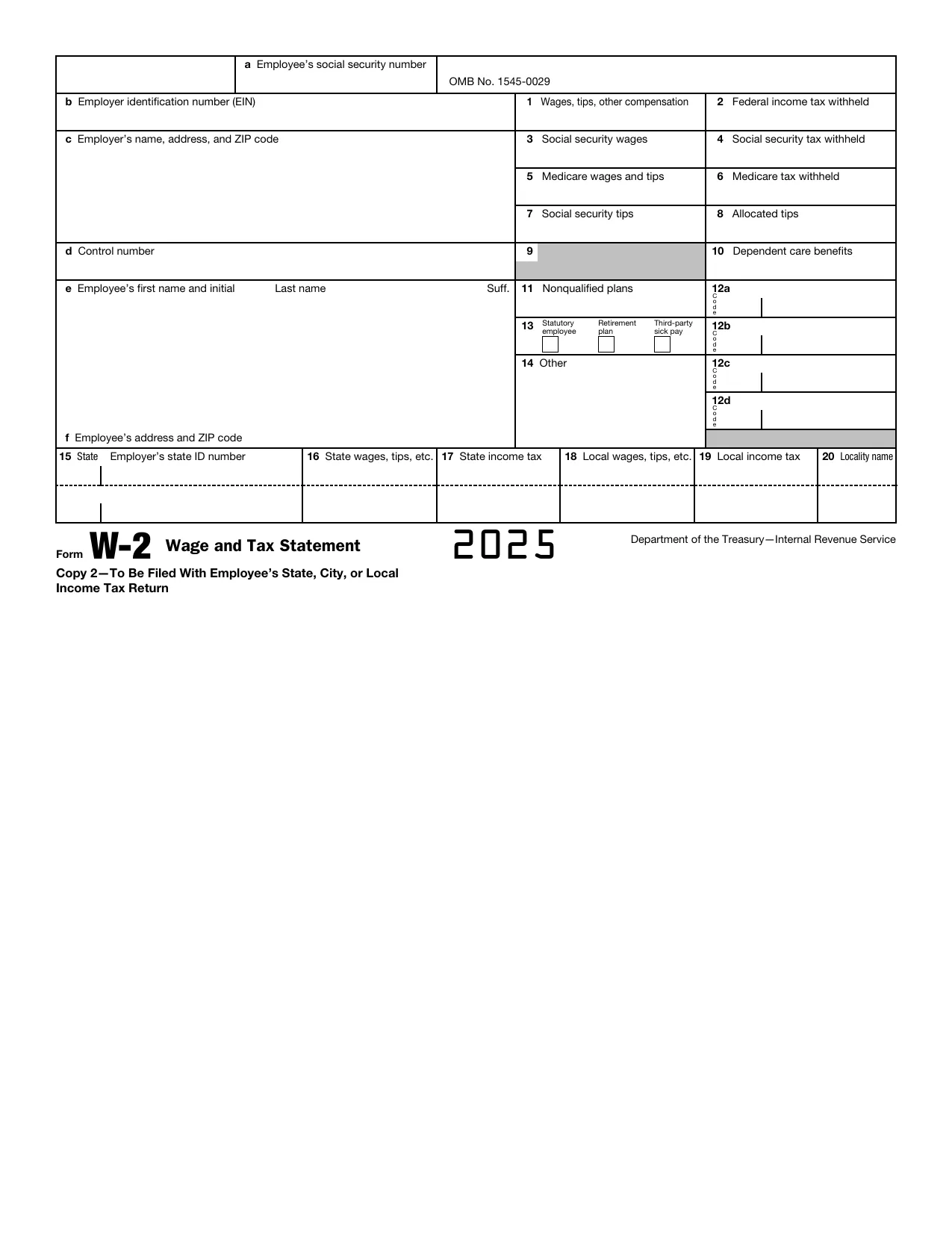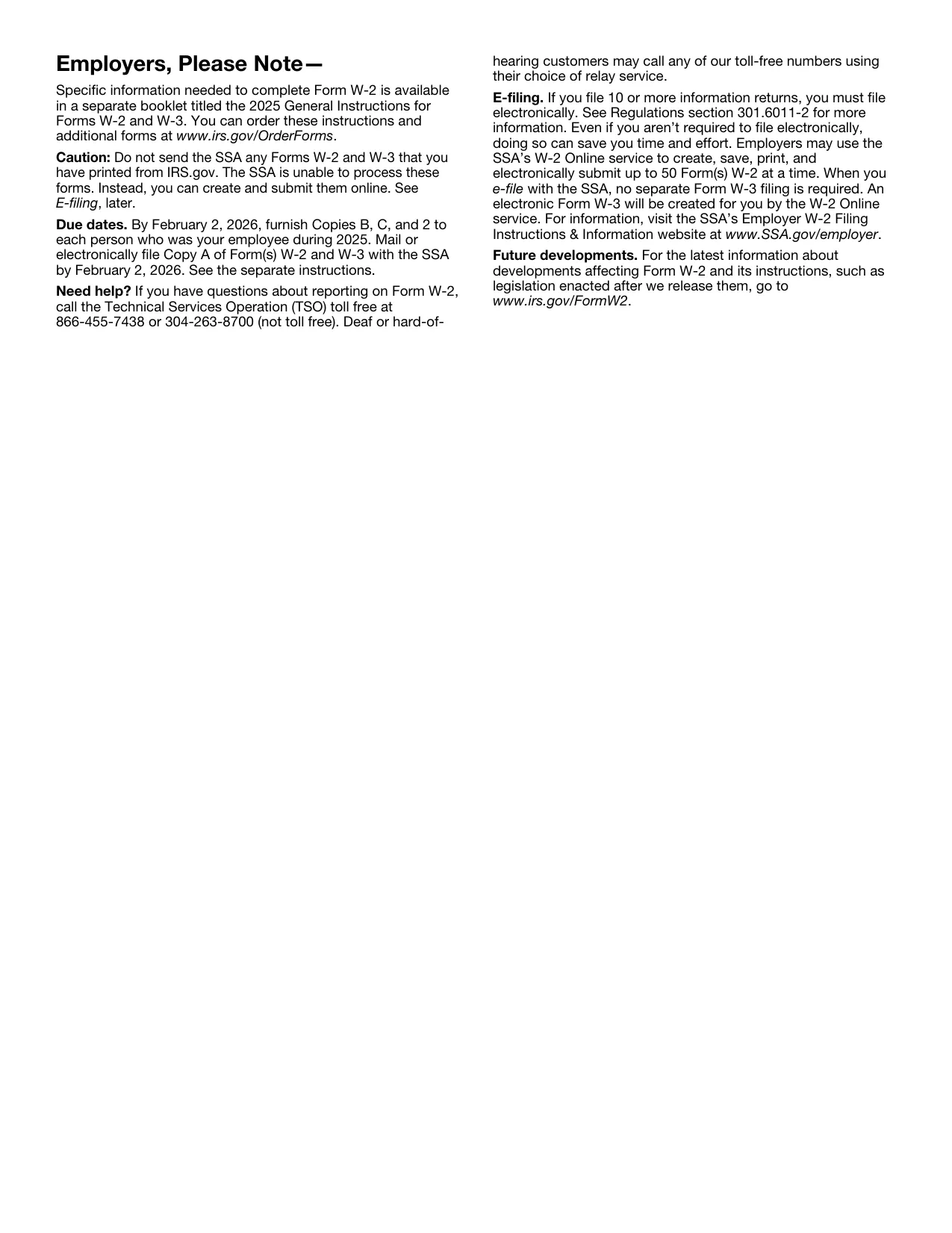Form W-2 2025 - Fill, Sign Online, Download & Print - No Signup
Attention:
You may file Forms W-2 and W-3 electronically on the SSA’s
Employer
W-2 Filing Instructions and Information
web page, which is also accessible
at
www.socialsecurity.gov/employer
. You can create fill-in versions of
Forms W-2 and W-3 for filing with SSA. You may also print out copies for
filing with state or local governments, distribution to your employees, and
for your records.
Note:
Copy A of this form is provided for informational purposes only. Copy A appears in
red, similar to the official IRS form. The official printed version of this IRS form is scannable,
but the online version of it, printed from this website, is not. Do
not
print and file Copy A
downloaded from this website with the SSA; a
penalty
may be imposed for filing forms that
can’t be scanned. See the penalties section in the current
General Instructions for Forms
W-2 and W-3
, available at
www.irs.gov/w2
, for more information.
Please note that Copy B and other copies of this form, which appear in black, may be
downloaded, filled in, and printed and used to satisfy the requirement to provide the
information to the recipient.
To order official IRS information returns such as Forms W-2 and W-3, which include a
scannable Copy A for filing, go to IRS’
Online Ordering for Information Returns and
Employer Returns
page, or visit
www.irs.gov/orderforms
and click on Employer and
Information returns. We’ll mail you the scannable forms and any other products you order.
See IRS Publications
1141
,
1167
, and
1179
for more information about printing these tax
forms.
22222
VOID
a
Employee’s social security number
For Official Use Only
OMB No. 1545-0029
b
Employer identification number (EIN)
c
Employer’s name, address, and ZIP code
d
Control number
e
Employee’s first name and initial
Last name
Suff.
f
Employee’s address and ZIP code
1
Wages, tips, other compensation
2
Federal income tax withheld
3
Social security wages
4
Social security tax withheld
5
Medicare wages and tips
6
Medicare tax withheld
7
Social security tips
8
Allocated tips
9
10
Dependent care benefits
11
Nonqualified plans
12a
See instructions for box 12
C
o
d
e
12b
C
o
d
e
12c
C
o
d
e
12d
C
o
d
e
13
Statutory
employee
Retirement
plan
Third-party
sick pay
14
Other
15
State
Employer’s state ID number
16
State wages, tips, etc.
17
State income tax
18
Local wages, tips, etc.
19
Local income tax
20
Locality name
Form
W-2
Wage and Tax Statement
2025
Department of the Treasury—Internal Revenue Service
For Privacy Act and Paperwork Reduction
Act Notice, see the separate instructions.
Cat. No. 10134D
Copy A—For Social Security Administration.
Send this entire page with
Form W-3 to the Social Security Administration; photocopies are
not
acceptable.
Do Not Cut, Fold, or Staple Forms on This Page
22222
a
Employee’s social security number
OMB No. 1545-0029
b
Employer identification number (EIN)
c
Employer’s name, address, and ZIP code
d
Control number
e
Employee’s first name and initial
Last name
Suff.
f
Employee’s address and ZIP code
1
Wages, tips, other compensation
2
Federal income tax withheld
3
Social security wages
4
Social security tax withheld
5
Medicare wages and tips
6
Medicare tax withheld
7
Social security tips
8
Allocated tips
9
10
Dependent care benefits
11
Nonqualified plans
12a
C
o
d
e
12b
C
o
d
e
12c
C
o
d
e
12d
C
o
d
e
13
Statutory
employee
Retirement
plan
Third-party
sick pay
14
Other
15
State
Employer’s state ID number
16
State wages, tips, etc.
17
State income tax
18
Local wages, tips, etc.
19
Local income tax
20
Locality name
Form
W-2
Wage and Tax Statement
2025
Department of the Treasury—Internal Revenue Service
Copy 1—For State, City, or Local Tax Department
a
Employee’s social security number
OMB No. 1545-0029
Safe, accurate,
FAST! Use
Visit the IRS website at
www.irs.gov/efile
.
b
Employer identification number (EIN)
c
Employer’s name, address, and ZIP code
d
Control number
e
Employee’s first name and initial
Last name
Suff.
f
Employee’s address and ZIP code
1
Wages, tips, other compensation
2
Federal income tax withheld
3
Social security wages
4
Social security tax withheld
5
Medicare wages and tips
6
Medicare tax withheld
7
Social security tips
8
Allocated tips
9
10
Dependent care benefits
11
Nonqualified plans
12a
See instructions for box 12
C
o
d
e
12b
C
o
d
e
12c
C
o
d
e
12d
C
o
d
e
13
Statutory
employee
Retirement
plan
Third-party
sick pay
14
Other
15
State
Employer’s state ID number
16
State wages, tips, etc.
17
State income tax
18
Local wages, tips, etc.
19
Local income tax
20
Locality name
Form
W-2
Wage and Tax Statement
2025
Department of the Treasury—Internal Revenue Service
Copy B—To Be Filed With Employee’s FEDERAL Tax Return.
This information is being furnished to the Internal Revenue Service.
Future developments.
For the latest information about
developments related to Form W-2, such as legislation enacted
after it was published, go to
www.irs.gov/FormW2
.
Notice to Employee
Do you have to file?
Refer to the Form 1040 instructions to
determine if you are required to file a tax return. Even if you
don’t have to file a tax return, you may be eligible for a refund if
box 2 shows an amount or if you are eligible for any credit.
Earned income tax credit (EITC).
You may be able to take the
EITC for 2025 if your adjusted gross income (AGI) is less than a
certain amount. The amount of the credit is based on income
and family size. Workers without children could qualify for a
smaller credit. You and any qualifying children must have valid
social security numbers (SSNs). You can’t take the EITC if your
investment income is more than the specified amount for 2025
or if income is earned for services provided while you were an
inmate at a penal institution. For 2025 income limits and more
information, visit
www.irs.gov/EITC
. See also Pub. 596.
Any
EITC that is more than your tax liability is refunded to you,
but only if you file a tax return.
Employee’s social security number (SSN).
For your
protection, this form may show only the last four digits of your
SSN. However, your employer has reported your complete SSN
to the IRS and the Social Security Administration (SSA).
Clergy and religious workers.
If you aren’t subject to
social
security and Medicare taxes, see Pub. 517.
Corrections.
If your name, SSN, or address is incorrect,
correct
Copies B, C, and 2 and ask your employer to correct
your
employment record. Be sure to ask the employer to file Form
W-2c, Corrected Wage and Tax Statement, with the
SSA to
correct any name,
SSN, or money amount error reported to the
SSA on Form
W-2. Be sure to get your copies of Form W-2c
from your employer for all corrections made so you may file
them with your tax return. If your name and SSN are correct but
aren’t the same
as shown on your social security card, you
should ask for a
new card that displays your correct name at
any SSA office
or by calling 800-772-1213. You may also visit
the SSA website at
www.SSA.gov.
Cost of employer-sponsored health coverage (if such cost is
provided by the employer).
The reporting in box 12, using
code DD, of the cost of employer-sponsored health coverage is
for your information only.
The amount reported with code DD
is not taxable.
Credit for excess taxes.
If you had more than one
employer in
2025 and more than $10,918.20 in social security
and/or Tier 1
railroad retirement (RRTA) taxes were withheld,
you may be able
to claim a credit for the excess against
your federal income tax.
See the Form 1040 instructions. If you had more than one
railroad
employer and more than $6,409.20 in Tier 2 RRTA tax
was
withheld, you may be able to claim a refund on Form 843.
See the Instructions for Form 843.
(See also
Instructions for Employee
on the back of Copy C.)
a
Employee’s social security number
OMB No. 1545-0029
This information is being furnished to the Internal Revenue Service. If you
are required to file a tax return, a negligence penalty or other sanction
may be imposed on you if this income is taxable and you fail to report it.
b
Employer identification number (EIN)
c
Employer’s name, address, and ZIP code
d
Control number
e
Employee’s first name and initial
Last name
Suff.
f
Employee’s address and ZIP code
1
Wages, tips, other compensation
2
Federal income tax withheld
3
Social security wages
4
Social security tax withheld
5
Medicare wages and tips
6
Medicare tax withheld
7
Social security tips
8
Allocated tips
9
10
Dependent care benefits
11
Nonqualified plans
12a
See instructions for box 12
C
o
d
e
12b
C
o
d
e
12c
C
o
d
e
12d
C
o
d
e
13
Statutory
employee
Retirement
plan
Third-party
sick pay
14
Other
15
State
Employer’s state ID number
16
State wages, tips, etc.
17
State income tax
18
Local wages, tips, etc.
19
Local income tax
20
Locality name
Form
W-2
Wage and Tax Statement
2025
Department of the Treasury—Internal Revenue Service
Copy C—For EMPLOYEE’S RECORDS
(See
Notice to Employee
on the back of Copy B.)
Safe, accurate,
FAST! Use
Instructions for Employee
(See also
Notice to
Employee
on the back of Copy B.)
Box 1.
Enter this amount on the wages line of your tax return.
Box 2.
Enter this amount on the federal income tax withheld
line of your
tax return.
Box 5.
You may be required to report this amount on Form 8959. See
the Form 1040 instructions to determine if you are required to complete
Form 8959.
Box 6.
This amount includes the 1.45% Medicare tax withheld on all
Medicare wages and tips shown in box 5, as well as the 0.9% Additional
Medicare Tax on any of those Medicare wages and tips above
$200,000.
Box 8.
This amount is
not
included in box 1, 3, 5, or 7. For
information
on how to report tips on your tax return, see the Form 1040 instructions.
You must file Form 4137 with your income tax return to report at least
the allocated tip amount unless you can prove with adequate records
that you received a smaller amount. If you have records that show the
actual amount of tips you received, report that amount even if it is more
or less than the allocated tips. Use Form 4137 to figure the social
security and Medicare tax owed on tips you didn’t report to your
employer. Enter this amount on the wages line of your tax return. By
filing Form 4137, your social security tips will be credited to your social
security record (used to figure your benefits).
Box 10.
This amount includes the total dependent care benefits that
your employer paid to you or incurred on your behalf (including
amounts
from a section 125 (cafeteria) plan). Any amount over
your employer’s
plan limit is also included in box 1. See Form 2441.
Box 11.
This amount is (a) reported in box 1 if it is a distribution
made to
you from a nonqualified deferred compensation or nongovernmental
section 457(b) plan, or (b) included in box 3 and/or box 5 if it is a prior
year deferral under a nonqualified or section 457(b) plan that became
taxable for social security and Medicare taxes this year because there is
no longer a substantial risk of forfeiture of your right to the deferred
amount. This box shouldn’t be used if you had a deferral and a
distribution in the same calendar year. If you made a deferral and
received a distribution in the same calendar year, and you are or will be
age 62 by the end of the calendar year, your employer should file Form
SSA-131, Employer Report of Special Wage Payments, with the Social
Security Administration and give you a copy.
Box 12.
The following list explains the codes shown in box 12. You may
need this information to complete your tax
return. Elective deferrals
(codes D, E, F, and S) and designated
Roth contributions (codes AA,
BB, and EE) under all plans are generally limited to a total of $23,500
(Generally, $16,500 for SIMPLE plans; $26,500 for section 403(b) plans if
you qualify for the 15-year rule explained in Pub. 571). Deferrals under
code G are limited to $23,500. Deferrals under code H are limited to
$7,000.
However, if you were at least age 50 in 2025, your employer may have
allowed an additional elective deferral or designated Roth contribution
(catch-up contribution) to your plan. For information about the limits on
these catch-up contributions, including the higher limit if you were age
60 through 63 as of December 31, 2025, see Pub. 525. Contact your
plan administrator for more information. Amounts in excess of the
overall elective deferral limit must be included in income. See the Form
1040 instructions.
Note:
If a year follows code D through H, S, Y, AA, BB, or EE, you
made
a make-up pension contribution for a prior year(s) when
you were in
military service. To figure whether you made excess
deferrals, consider
these amounts for the year shown, not the
current year. If no year is
shown, the contributions are for the
current year.
A—
Uncollected social security or RRTA tax on tips. Include this
tax on
Form 1040 or 1040-SR. See the Form 1040 instructions.
B—
Uncollected Medicare tax on tips. Include this tax on Form
1040 or
1040-SR. See the Form 1040 instructions.
C—
Taxable cost of group-term life insurance over $50,000
(included in
boxes 1, 3 (up to the social security wage base), and 5)
D—
Elective deferrals to a section 401(k) cash or deferred
arrangement.
Also includes deferrals under a SIMPLE retirement
account that is part
of a section 401(k) arrangement.
E—
Elective deferrals under a section 403(b) salary reduction
agreement
(continued on back of Copy 2)
a
Employee’s social security number
OMB No. 1545-0029
b
Employer identification number (EIN)
c
Employer’s name, address, and ZIP code
d
Control number
e
Employee’s first name and initial
Last name
Suff.
f
Employee’s address and ZIP code
1
Wages, tips, other compensation
2
Federal income tax withheld
3
Social security wages
4
Social security tax withheld
5
Medicare wages and tips
6
Medicare tax withheld
7
Social security tips
8
Allocated tips
9
10
Dependent care benefits
11
Nonqualified plans
12a
C
o
d
e
12b
C
o
d
e
12c
C
o
d
e
12d
C
o
d
e
13
Statutory
employee
Retirement
plan
Third-party
sick pay
14
Other
15
State
Employer’s state ID number
16
State wages, tips, etc.
17
State income tax
18
Local wages, tips, etc.
19
Local income tax
20
Locality name
Form
W-2
Wage and Tax Statement
2025
Department of the Treasury—Internal Revenue Service
Copy 2—To Be Filed With Employee’s State, City, or Local
Income Tax Return
Instructions for Employee
(continued from back of
Copy C)
Box 12
(continued)
F—
Elective deferrals under a section 408(k)(6) salary
reduction SEP (this
includes elective deferrals made to a Roth SEP IRA)
G—
Elective deferrals and employer contributions (including
nonelective
deferrals) to a section 457(b) deferred
compensation plan
H—
Elective deferrals to a section 501(c)(18)(D) tax-exempt
organization
plan. See the Form
1040 instructions for how to deduct.
J—
Nontaxable sick pay (information only, not included in
box 1, 3, or 5)
K—
20% excise tax on excess golden parachute payments.
See the
Form
1040 instructions.
L—
Substantiated employee business expense
reimbursements
(nontaxable)
M—
Uncollected social security or RRTA tax on taxable cost
of group-
term life insurance over $50,000 (former employees
only). See the Form
1040 instructions.
N—
Uncollected Medicare tax on taxable cost of group-term
life
insurance over $50,000 (former employees only). See
the Form
1040
instructions.
P—
Excludable moving expense reimbursements paid
directly to a
member of the U.S. Armed Forces (not included in box 1, 3, or 5)
Q—
Nontaxable combat pay. See the Form 1040 instructions for details
on reporting this amount.
R—
Employer contributions to your Archer MSA. Report on
Form 8853.
S—
Employee salary reduction contributions under a section
408(p)
SIMPLE plan (this includes salary reduction contributions made to a
Roth SIMPLE IRA)
T—
Adoption benefits (not included in box 1). Complete Form 8839 to
figure any taxable and nontaxable amounts.
V—
Income from exercise of nonstatutory stock option(s)
(included in
boxes 1, 3 (up to the social security wage base),
and 5). See Pub. 525
for reporting requirements.
W—
Employer contributions (including amounts the employee elected to
contribute using a section 125 (cafeteria) plan) to your health savings
account.
Report on Form 8889.
Y—
Deferrals under a section 409A nonqualified deferred compensation
plan
Z—
Income under a nonqualified deferred compensation plan that fails
to satisfy section 409A. This amount is also included in box 1. It
is
subject to an additional 20% tax plus interest. See the Form 1040
instructions.
AA—
Designated Roth contributions under a section 401(k)
plan
BB—
Designated Roth contributions under a section 403(b)
plan
DD—
Cost of employer-sponsored health coverage.
The amount
reported with code DD is not taxable.
EE—
Designated Roth contributions under a governmental section
457(b) plan. This amount does not apply to contributions under a tax-
exempt organization section 457(b) plan.
FF—
Permitted benefits under a qualified small employer health
reimbursement arrangement
GG—
Income from qualified equity grants under section 83(i)
HH—
Aggregate deferrals under section 83(i) elections as of the close of
the calendar year
II—
Medicaid waiver payments excluded from gross income under
Notice 2014-7
Box 13.
If the “Retirement plan” box is checked, special
limits may
apply to the amount of traditional IRA
contributions you may deduct.
See Pub. 590-A.
Box 14.
Employers may use this box to report information such as state
disability insurance taxes withheld, union dues, uniform payments,
health insurance premiums deducted, nontaxable income, educational
assistance payments, or a member of the clergy’s parsonage allowance
and utilities. Railroad employers use this box to report railroad
retirement (RRTA) compensation, Tier 1 tax, Tier 2 tax, Medicare tax,
and Additional Medicare Tax. Include tips reported by the employee to
the employer in railroad retirement (RRTA) compensation.
Note:
Keep
Copy C
of Form W-2 for at least 3 years after
the due date
for filing your income tax return. However, to
help
protect your social
security benefits
, keep Copy C
until you begin receiving social security
benefits, just in case
there is a question about your work record and/or
earnings
in a particular year.
VOID
a
Employee’s social security number
OMB No. 1545-0029
b
Employer identification number (EIN)
c
Employer’s name, address, and ZIP code
d
Control number
e
Employee’s first name and initial
Last name
Suff.
f
Employee’s address and ZIP code
1
Wages, tips, other compensation
2
Federal income tax withheld
3
Social security wages
4
Social security tax withheld
5
Medicare wages and tips
6
Medicare tax withheld
7
Social security tips
8
Allocated tips
9
10
Dependent care benefits
11
Nonqualified plans
12a
See instructions for box 12
C
o
d
e
12b
C
o
d
e
12c
C
o
d
e
12d
C
o
d
e
13
Statutory
employee
Retirement
plan
Third-party
sick pay
14
Other
15
State
Employer’s state ID number
16
State wages, tips, etc.
17
State income tax
18
Local wages, tips, etc.
19
Local income tax
20
Locality name
Form
W-2
Wage and Tax Statement
2025
Department of the Treasury—Internal Revenue Service
For Privacy Act and Paperwork Reduction
Act Notice, see separate instructions.
Copy D—For Employer
Employers, Please Note—
Specific information needed to complete Form W-2 is available
in a separate booklet titled the 2025 General Instructions for
Forms W-2 and W-3. You can order these instructions and
additional forms at
www.irs.gov/OrderForms
.
Caution:
Do not send the SSA any Forms W-2 and W-3 that you
have printed from IRS.gov. The SSA is unable to process these
forms. Instead, you can create and submit them online. See
E-filing
, later.
Due dates.
By February 2, 2026, furnish Copies B, C, and 2 to
each person who was your employee during 2025. Mail or
electronically file Copy A of Form(s) W-2 and W-3 with the SSA
by February 2, 2026. See the separate instructions.
Need help?
If you have questions about reporting on Form W-2,
call the Technical Services Operation (TSO) toll free at
866-455-7438 or 304-263-8700 (not toll free). Deaf or hard-of-
hearing customers may call any of our toll-free numbers using
their choice of relay service.
E-filing.
If you file 10 or more information returns, you must file
electronically. See Regulations section 301.6011-2 for more
information. Even if you aren’t required to file electronically,
doing so can save you time and effort. Employers may use the
SSA’s W-2 Online service to create, save, print, and
electronically submit up to 50 Form(s) W-2 at a time. When you
e-file
with the SSA, no separate Form W-3 filing is required. An
electronic Form W-3 will be created for you by the W-2 Online
service. For information, visit the SSA’s Employer W-2 Filing
Instructions & Information website at
www.SSA.gov/employer
.
Future developments.
For the latest information about
developments affecting Form W-2 and its instructions, such as
legislation enacted after we release them, go to
www.irs.gov/FormW2
.

